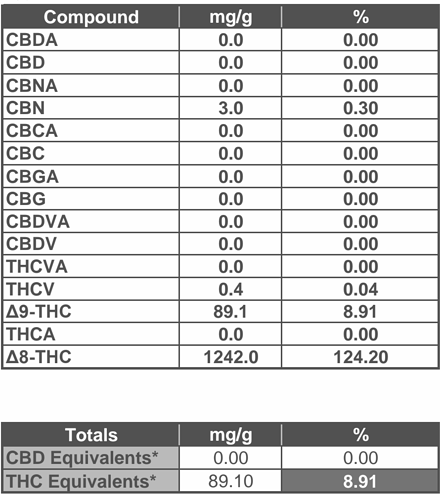Haven’t seen neither.
Lowest I ve seen so far is still above 2%.
I use a t5 process that works really well and just remove the solids. Analysis shows 90 10 d8 d9. I don’t have a distillation column though
You can always run it through a column instead.
If d9 is still there, it means that the reaction was not achieved. The test saying that it is pure d9+d8 does not really make sense. Threre should be quite some d10 in there too, and not as much d8, perhaps max 70%.
I agree with the doctor, those are unusual results for a t5 reflux. Have you had your product tested by a third party lab?
We get that easily with our process. That screenshot is before purification
Those results are standard for a ptsa reflux. I’ve never seen results like that from a clay reflux. That’s very interesting.
How do you achieve 137%?
Lol right?
Magic. That or improper dilution/sample prep with lazy, untrained technicians determining the results. And no retest to validate such a wildy inaccurate measurement of cannabinoids.
Cal mag
Cause that analysis is on neat material not finished good. Absolute value is important for something like an edible, only relative value matters for analysis of neat material.
Lazy my ass. I instructed them to run it without absolute quantification. Ive spent a large part of my career running hplc and this is fine for analytical purposes since we care about relative amounts. The important part is to not saturate the column or detector
Also for those of you wanting to argue, if this were an error it would be related to improper dilution of a calibrator or the sample itself. However, since IDGAF about that I just run next to a reference standard
Wasn’t trying to argue or start a fight. I certainly don’t claim to be an expert in analytics, but I’m also not entirely untrained (hence my making the same claims for error as you just have). I’m also, personally, not fond of values grossly in excess of 100% on my test results. We also have have very limited info from that testing, so who I am to say anything. Sorry if I offended you. Certainly was not my intention.
No sorry I tend to be a little defensive and shouldn’t off the gun be a dick. My bad. My point to be here is to try to learn something so I should be more open to others comments. Something about being behind a keyboard makes it so easy to be a dick. Anyways, on other notes. I really had to talk to our analyzing house about this because when we send pure resin samples they are really hard to analyze since the total cannabinoid concentration is teetering near 100%. As a result getting dilutions to be exact with such samples was very challenging. Since in the past we have sent dozens of research samples at a time we resorted to allowing them to worry less about absolute concentration. For our purposes we cared about how much CBD we are concerting (CBD abundance), and once it is conveted what is the relative abundance of our d9 d8. For that reason these analyses were used for screening prior to more thorough analyses of structures and side products
@YumYam What you’re saying is the percentages were not as important you were merely looking for the presence of Delta9? That makes sense to me. I run stuff a little sloppy sometimes because I’m not as concerned about the concentration as much as I am about what else happened.
For example, I just ran a short path run of a CBN reaction I tried and I ran it into a flask that still had some CBD, so if I see CBD in there I know where that came from but I’m more looking for the presence of CBN.
Not just the presence of d9 but the d8 as well. Assuming I had started with pure CBD and all the CBD goes away then I can measure selectivity for d8 over d9 in my processes. My development strategy is to identify factors affecting total conversion and selectivity. The analysis of side products is better suited for nmr and analytical hplc, not drug lab hplc. For me to access those tools I have to pay a lot more, so I’m only gonna put my best horse up for those additional analyses.
I suspect that I’m not fully understanding what you’re saying. If you aren’t doing in depth testing that reveals the presence of unknowns or accurately testing for potency than how could your methods determine catalyst specificity?
